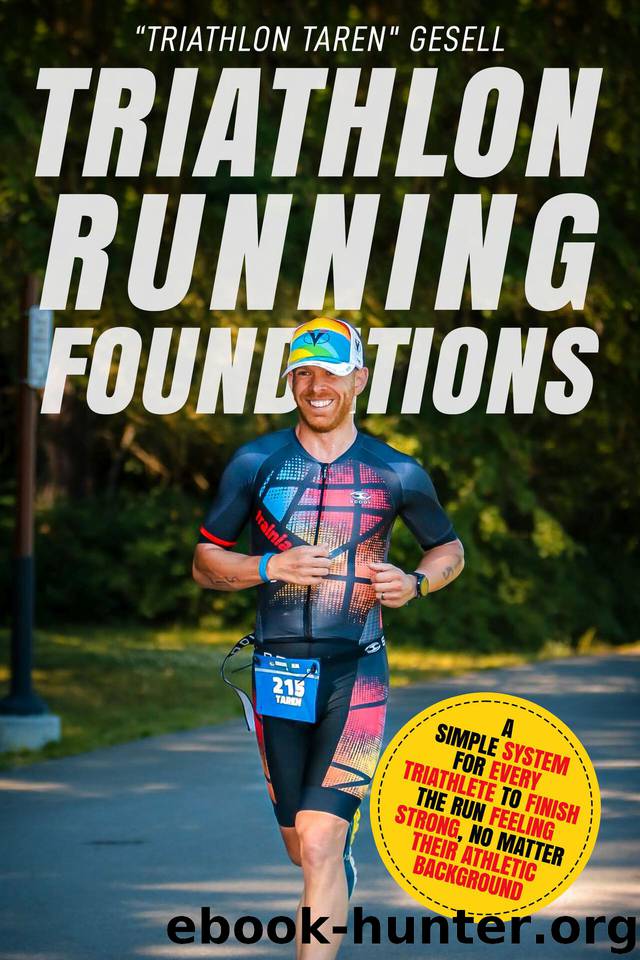Triathlon Running Foundations: A Simple System for Every Triathlete to Finish the Run Feeling Strong, No Matter Their Athletic Background by Gesell “Triathlon Taren”

Author:Gesell, “Triathlon Taren” [Gesell, “Triathlon Taren”]
Language: eng
Format: epub
Publisher: Triathlon Taren" Gesell
Published: 2020-06-11T16:00:00+00:00
CHAPTER 4
TRIATHLON RUNNING SETUP
I once spent a week in Tucson, Arizona with two-time USA Olympian in triathlon, Sarah True, and her husband, Ben True. (Ben is also an amazing runner who held the all-time US 5K road record at 13:22. Crazy, right?)
You might think these two athletes, some of the best runners in the world, have their running gear dialled in to the exact, best possible setup. Specifically chosen shoes, the best running watch possible (with a screen customized to have the optimal fields showing), brand new heart rate monitors… But you’d be wrong if that’s what you pictured.
Ben is sponsored by Garmin. He told me Garmin always asks him what he wants in a running watch. “If it can tell me the time of day, I’m pretty happy,” he said.
You might think Ben’s an outlier. But, when Sarah was talking about her shoe selection, she said, “I really love these new HOKAs they sent me, they feel great!” I asked her which model they were and she said, “Good question. I don’t know.” She didn’t look at the model, the heel-to-toe drop, how much the shoe weighed or how much carbon was in the shoe. HOKA sent out boxes of shoes for her to try and she used what felt right.
I’ll go one step farther to reinforce that Sarah and Ben aren’t just luddites. I once got paced for a 5000 meter time trial track run by Corey Gallagher, who was the reigning World Beer Mile Champion, and winner of just about every major local running race over the previous few years. He asked me what I thought I would be able to run. I told him a 19:30, which works out to 93.6 seconds for every 400-meter lap.
Corey nodded and said, “Got it!” But I looked at his wrist and saw he wasn’t wearing a watch. I walked over to the friend who had arranged the time trial and asked how Corey was going to pace me. He said, “He’ll just dial in the pace.” Apparently, he knew exactly what every pace felt like.
During the first lap of the run, I was constantly looking at the laptop on my wrist (aka, my running watch) to make sure Corey wasn’t way off the pace and was going to blow me up. As we passed the lap marker, the person timing the run yelled out, “95 seconds!” Corey was within one-and-a-half seconds of the target. The next lap was, “92 seconds.” After that, he dialled it right in, and every single lap was either “93 seconds,” or “94 seconds” like clockwork.
Corey let me go on my own for the final two laps. I did the time trial in 19:22. I was amazed at how metronome-like he was with his pacing, even though that pace was totally foreign to him. It was almost a minute slower per kilometer than his normal race effort.
I went over to my buddy and (after nearly throwing up from the effort of the run), I asked how Corey did that.
Download
This site does not store any files on its server. We only index and link to content provided by other sites. Please contact the content providers to delete copyright contents if any and email us, we'll remove relevant links or contents immediately.
Shoe Dog by Phil Knight(5147)
The Rules Do Not Apply by Ariel Levy(4870)
Walking by Henry David Thoreau(3897)
How to Read Water: Clues and Patterns from Puddles to the Sea (Natural Navigation) by Tristan Gooley(3410)
Running Barefoot by Amy Harmon(3398)
I'll Give You the Sun by Jandy Nelson(3363)
Crazy Is My Superpower by A.J. Mendez Brooks(3334)
How to Read Nature by Tristan Gooley(3253)
How Music Works by David Byrne(3191)
The Boy, the Mole, the Fox and the Horse by Charlie Mackesy(3002)
The Fight by Norman Mailer(2849)
Seducing Cinderella by Gina L. Maxwell(2605)
Cuba by Lonely Planet(2579)
Accepted by Pat Patterson(2310)
Going Long by Editors of Runner's World(2298)
The Unfettered Mind: Writings from a Zen Master to a Master Swordsman by Takuan Soho(2249)
The Happy Runner by David Roche(2195)
Backpacker the Complete Guide to Backpacking by Backpacker Magazine(2194)
Trail Magic by Trevelyan Quest Edwards & Hazel Edwards(2127)
